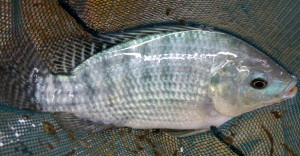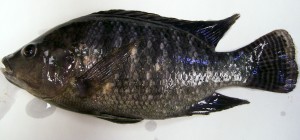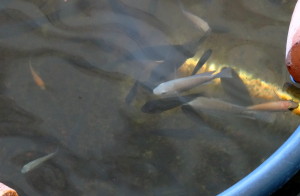Tilapia (Oreochromis niloticus )
Common Names: Nile Tilapia, Nile perch, Redbelly Tilapia, freshwater snapper, mojara, ngege, St. Peter’s fish



Tilapia is the second most prolific species grown in aquaculture after carp, and the most widely grown fish on earth. Tilapia is farmed in *5 countries with the largest producers being Asian countries such as China and Indonesia. Consumer markets have expanded greatly throughout the 2000’s due to improved breeding strategies, hybridization and sex reversal. According to the National Fisheries Institute tilapia is on the top ten list of the most consumed fish in the United States. Chances are if you’ve eaten fish at a restaurant you’ve eaten tilapia.
Range: Tilapia are native only to Africa and many U.S. States consider them an invasive, or non-indigenous species. Tilapia have been introduced around the world into fresh and brackish waters, sometimes deliberately for the purpose of controlling aquatic plant growth. In the United States, wild populations of tilapia can be found in Southern California and several lakes and waterways in Texas.
Description: Tilapia are a hardy, fast growing fish, that can live up to ten years and reach ten pounds in weight. Tilapia are shaped like a sunfish or crappie and are easily identifiable by the interrupted lateral line characteristic of the Chiclid family of fishes. They are laterally compressed with deep bodies and have long dorsal fins. The foremost portion of the dorsal fin is heavily spined. Spines are also found in the pelvic and anal fins. They are usually wide vertical bars of dark coloration found along the sides of fry, fingerlings, and sometimes adults.
Biology and Life History: In the wild, tilapia are found in turbid rives and lakes. They are herbivores who feed mainly on plankton, algae, and other vegetable matter. As a result of their feeding patterns they do not accumulate toxins in their bodies. Wild tilapia can spawn throughout the year, with females producing as many as 1,200 eggs per spawn. Some species deposit eggs into nests while other species are mouth brooders carrying fry in the mouths of the males for protection from predators. Most widely farmed are the mouth brooding species because even though they lay fewer eggs the fry have a much higher survival rate. Tilapia are farmed in both intensive and extensive aquaculture systems. Most farmers prefer open air earthen ponds. Under ideal farming conditions females spawn every 17 days. If water quality and temperatures are manipulated to a favorable environment market sized fish can be obtained in seven to ten months. In areas of the southern United States, tilapia production is strictly regulated to reduce unwanted introductions of the species into native waters, for fear that they might damage sport fish populations.
Stocking: To produce one pound fish, the common practice is to stock 5,000 to 8,000 fish per acre. In static water ponds with aeration 20,000 to 28,000 males per acre with a 20% water exchange. According to Texas Parks and Wildlife an exotic species permit is required to stock and transport tilapia.
Texas Administrative Code:
(i) A person may transport Mozambique tilapia or triploid grass carp to a private pond or facility or possess Mozambique tilapia in a private pond or facility subject to compliance with §57.116(d) of this title (relating to Exotic Species Transport Invoice). Mozambique tilapia and triploid grass carp possessed in a private pond or facility may be removed from those premises only if gutted or beheaded.
Adapted From:
https://www.agmrc.org/commodities-products/aquaculture/aquaculture-fin-fish-species#Tilapia
